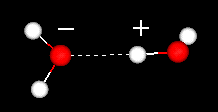Why do solids, liquids and gases behave differently?
The Case of H2O
Water can exist as a solid (ice), liquid (water liquid), or gas (water vapor). The basic molecular formula for the water molecule is the same in each H2O. But, as the temperature of the system changes the hydrogen bonds between water molecules change drastically.
What is a hydrogen bond?
In chemistry, a hydrogen bond is a type of attractive intermolecular force that exists between two partial electric charges of opposite polarity. Although stronger than most other intermolecular forces, the hydrogen bond is much weaker than both the ionic bond and the covalent bond.
 |
Two water molecules showing their hydrogen bond. For more details see: the water dimer. | |
What are the properties of a solid?
A substance in a solid phase is relatively rigid, has a definite volume and shape.
The atoms or molecules that comprise a solid are packed close together and are not compressible.
Because all solids have some thermal energy, its atoms do vibrate. However, this movement is very small and very rapid, and cannot be observed under ordinary conditions. Read more about states of matter.
|
Hydrogen bonds in ice shown in green O-O distance in ice = 2.76 A HO hydrogen bond distance in ice is = 1.76 A Check these numbers out 1) Stop spin 2)Double click on one atom 3)Drag mouse then double click on 2nd atom |
What are the properties of a Liquid?
Liquids have a definite volume, but are able to change their shape by flowing.
Liquids are similar to solids in that the particles touch. However the particles are able to move around.
Since particles are able to touch the densities of liquid will be close to that of a solid. Hbond distances will be greater in liquid water than ice.
Since the liquid molecules can move they will take the shape of their container. Read more about states of matter.
|
Hydrogen bonds in liquid water What is the hydrogen bond distance in water?
|
What are the properties of a Gas?
Gases have no definite volume or shape. If unconstrained gases will spread out indefinitely. If confined they will take the shape of their container. This is because gas particle have enough energy to overcome attractive forces. Each of the particles are well separated resulting in a very low density.
We can calculate an approximate value for number of water molecules in the above box when in a gas state using the following information:
Avogadros number 6 x 1023mol−1
Saturation density of water at 20 o C = 17.8 g/m3( source)
1 mole of water = 18 g
1 cu m= 10-30 cu. nm.
A water molecule is considered to be in the vapor phase if its distance from the center of particle exceeded 6 nm (60 Angstroms).. http://pubs.acs.org/doi/abs/10.1021/jp076442f
Read more about states of matter.
|
Gas molecules are too far apart for hydrogen bonding! Are these two molecules more than 60 Angstroms apart? Try this: 1)Click spin off 2)Click space fill 3)Double click an oxygen of one of the molecules 4)Drag the mouse and double click on oxygen of the 2nd molecule. Is the distance between the two molecules more than 6nm or 60A?
|
Explain it with Molecules
- Why is water such a good solvent?
- Why does ice float?
- Why do solids, liquids and gases behave differently?
- What is the geometry of methane?
- What's the difference between alpha and beta glucose?
- How does caffeine work in the brain?
- How does soap work?
- What is the difference between sucrose and fructose?
- Why is carbon monoxide so dangerous?
- Why is graphite so soft if it is made of only carbon?
- What is the difference between Carbyne and Graphite?
- Why is the fullerene and similar structures the cornerstone of nanotechnology?
- How big is a nanotube?
- Why does table salt have a cubic crystal shape?
- What is the structure of the benzene molecule?
- Why do carcinogens cause cancer?
- What causes Sickle Cell Anemia?
- What is the difference between sodium nitrite and nitrate?
- How do drugs work?
World of Molecules
- The Periodic Table of Elements
- What is a Molecule?-- When is a Molecule also a Compound?
- 3D Structures using Jsmol/Jmol
- Explain it with Molecules
- Healthy Molecules from Exercise
- Acid and Base Molecules